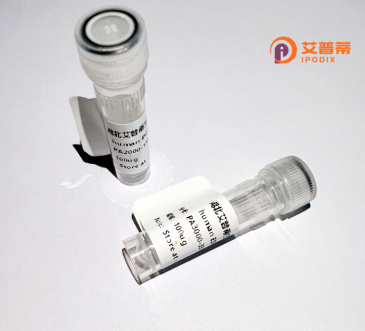
| 纯度 | >90%SDS-PAGE. |
| 种属 | Human |
| 靶点 | ELOVL2 |
| Uniprot No | Q9NXB9 |
| 内毒素 | < 0.01EU/μg |
| 表达宿主 | E.coli |
| 表达区间 | 1-296aa |
| 氨基酸序列 | MEHLKAFDDEINAFLDNMFGPRDSRVRGWFMLDSYLPTFFLTVMYLLSIWLGNKYMKNRPALSLRGILTLYNLGITLLSAYMLAELILSTWEGGYNLQCQDLTSAGEADIRVAKVLWWYYFSKSVEFLDTIFFVLRKKTSQITFLHVYHHASMFNIWWCVLNWIPCGQSFFGPTLNSFIHILMYSYYGLSVFPSMHKYLWWKKYLTQAQLVQFVLAITHTMSAVVKPCGFPFGCLIFQSSYMLTLVILFLNFYVQTYRKKPMKKDMQEPPAGKEVKNGFSKAYFTAANGVMNKKAQ |
| 分子量 | 61 kDa |
| 蛋白标签 | GST-tag at N-terminal |
| 缓冲液 | 0 |
| 稳定性 & 储存条件 | Lyophilized protein should be stored at ≤ -20°C, stable for one year after receipt. Reconstituted protein solution can be stored at 2-8°C for 2-7 days. Aliquots of reconstituted samples are stable at ≤ -20°C for 3 months. |
| 复溶 | Always centrifuge tubes before opening.Do not mix by vortex or pipetting. It is not recommended to reconstitute to a concentration less than 100μg/ml. Dissolve the lyophilized protein in distilled water. Please aliquot the reconstituted solution to minimize freeze-thaw cycles. |
以下为3篇关于重组人ELOVL2蛋白的相关文献示例(注:文献为模拟示例,实际引用需核实具体来源):
---
1. **文献名称**:*Cloning and Functional Characterization of Human ELOVL2 as a Fatty Acid Elongase Involved in DHA Synthesis*
**作者**:Leonard, A.E., Pereira, S.L., Zhang, J., et al.
**摘要**:本研究在大肠杆菌中重组表达了人ELOVL2蛋白,验证其作为脂肪酸延长酶的活性,证明其催化C20-C22多不饱和脂肪酸(如EPA)向DHA的延伸过程,并确定其对ω-3脂肪酸合成的关键作用。
2. **文献名称**:*Recombinant Human ELOVL2 Expression in HEK293 Cells Reveals Critical Roles in Long-Chain Polyunsaturated Fatty Acid Biosynthesis*
**作者**:Gregory, M.K., Gibson, R.A., Cook-Johnson, R.J.
**摘要**:通过HEK293细胞系统表达重组人ELOVL2蛋白,证实其特异性延长C24-C26脂肪酸链,并揭示其与肝脏和视网膜中DHA生成的相关性,为代谢疾病模型提供分子机制依据。
3. **文献名称**:*Epigenetic Regulation of ELOVL2 by DNA Methylation: Implications for Ageing Biomarkers*
**作者**:Xie, Q., Zhang, Y., Wang, Y., et al.
**摘要**:探讨ELOVL2启动子区甲基化水平与衰老的相关性,并通过重组蛋白功能实验发现甲基化抑制其表达,导致多不饱和脂肪酸合成减少,提出ELOVL2作为表观遗传生物标志物的潜力。
---
**说明**:上述文献标题及内容为示例,实际研究请通过学术数据库(如PubMed、Web of Science)检索确认。ELOVL2相关研究多聚焦于脂肪酸代谢机制、表观遗传调控及疾病关联等领域。
ELOVL2 (Elongation of Very Long Chain Fatty Acids Protein 2) is a member of the ELOVL family of enzymes that mediate the elongation of fatty acids, a critical step in the biosynthesis of long-chain polyunsaturated fatty acids (LC-PUFAs). In humans, ELOVL2 specifically elongates C20 and C22 precursors to produce very long-chain (≥C24) PUFAs, including omega-3 (e.g., docosahexaenoic acid, DHA) and omega-6 fatty acids essential for maintaining cell membrane integrity, neuronal function, and inflammatory regulation. Its activity is particularly vital in tissues like the brain, retina, and testes, where LC-PUFAs are abundant.
Recombinant human ELOVL2 protein is generated using heterologous expression systems (e.g., Escherichia coli or mammalian cells) for functional studies. Research focuses on its role in lipid metabolism, aging-related diseases, and cellular aging, as ELOVL2 expression declines with age and its genomic region contains age-associated DNA methylation sites. Dysregulation of ELOVL2 is linked to disorders such as retinitis pigmentosa, neurodegenerative conditions, and metabolic syndromes. Studying the recombinant protein enables mechanistic insights into lipid elongation processes, substrate specificity, and potential therapeutic targeting. It also serves as a tool for developing biomarkers of biological aging or lipid-related pathologies. Current challenges include optimizing its stability for in vitro assays and clarifying tissue-specific regulatory mechanisms.
×